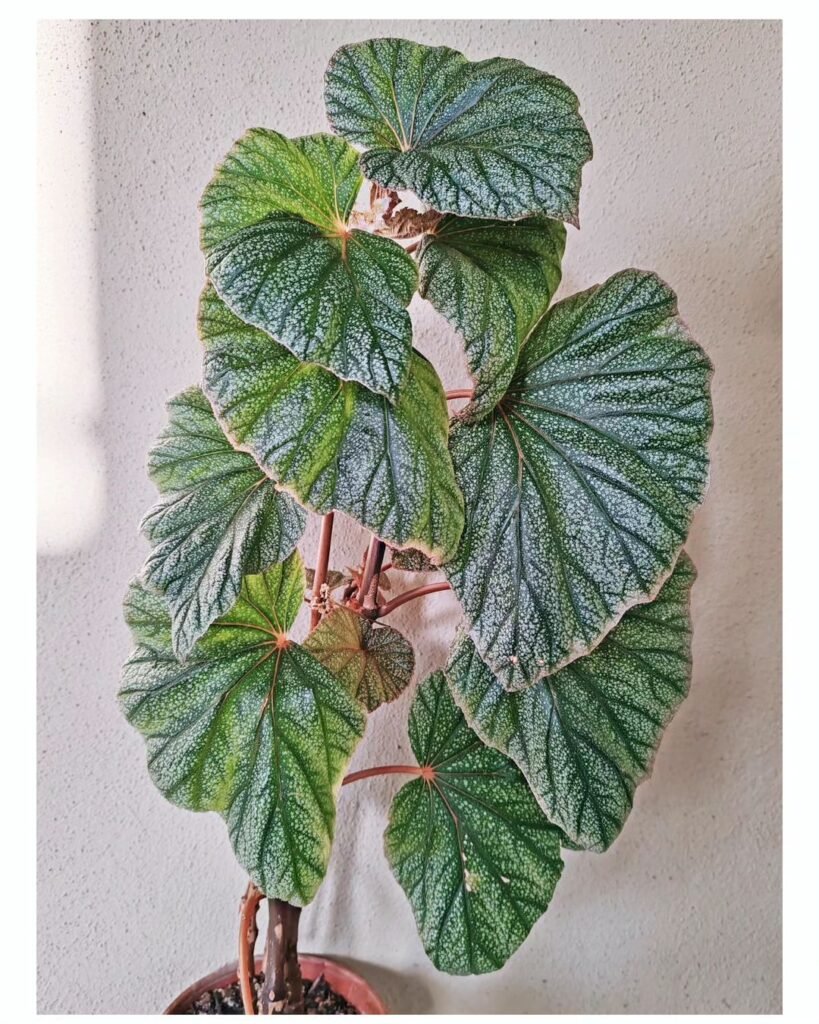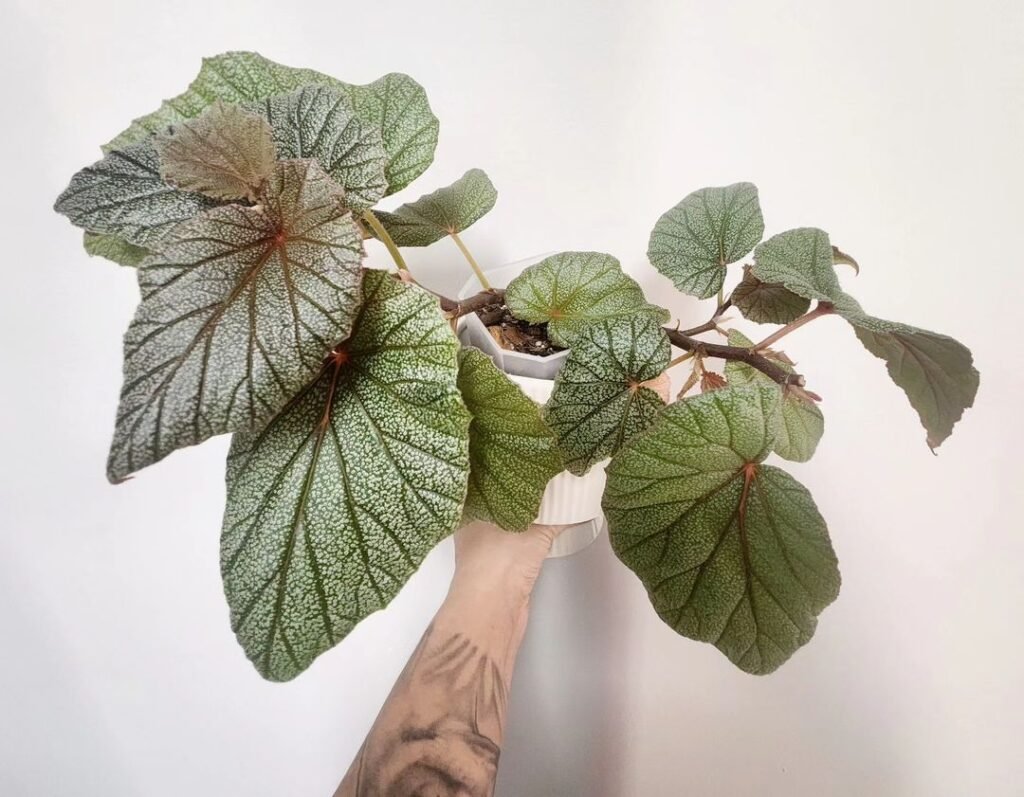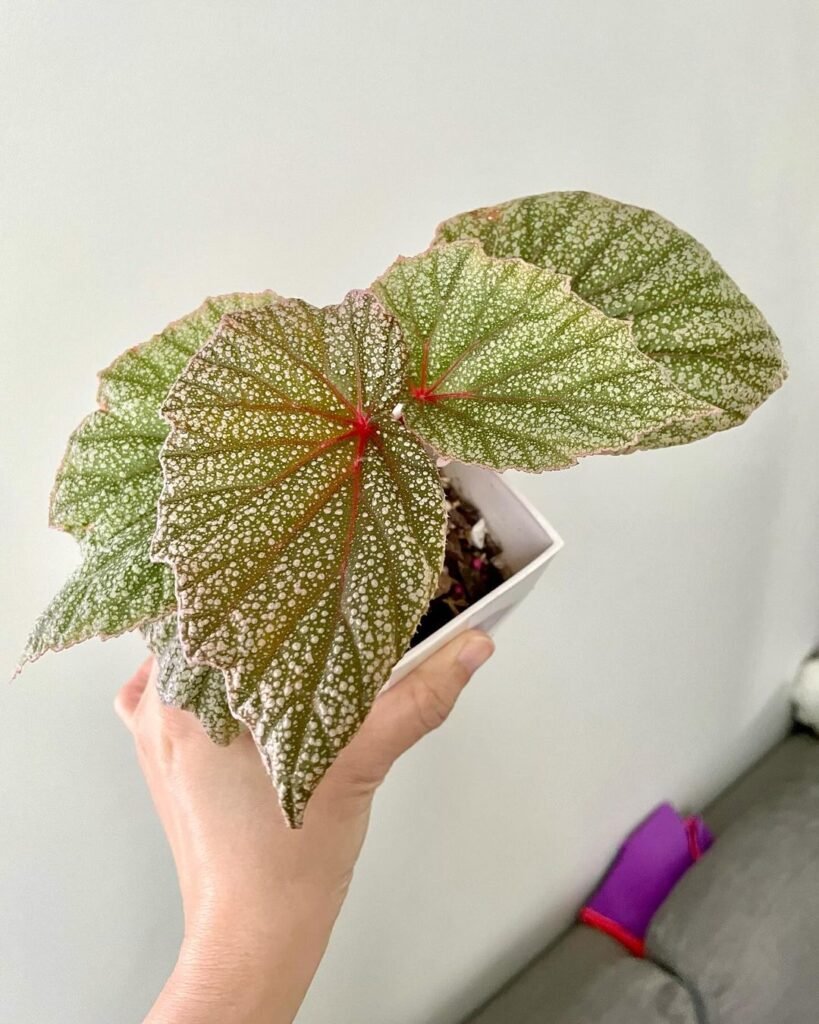Begonia Sinbad, a captivating member of the begonia family, is a botanical wonder that graces gardens and indoor spaces alike. Begonia Sinbad is renowned for its unique foliage, distinctive patterns, and ease of care.
This tropical beauty has become a favorite among plant enthusiasts due to its striking visual appeal and adaptable nature.
Begonia Sinbad Origins
Native to the tropical regions of Southeast Asia, Begonia Sinbad belongs to the Begoniaceae family, which encompasses a wide variety of begonia species. The name “Sinbad” hints at the adventurous spirit of this plant, as it explores new heights in both indoor and outdoor settings.
Characteristics and Traits
Begonia Sinbad boasts asymmetrical, angel-wing-shaped leaves that showcase a vibrant green hue with silver speckles. The leaves can grow up to 12 inches in length, adding a lush and luxurious touch to any space. This begonia variety is appreciated not only for its visual appeal but also for its relatively compact size, making it an excellent choice for various environments.



Begonia Sinbad Care Guide Overview
Caring for Begonia Sinbad is a rewarding experience, as it doesn’t demand excessive attention but rewards with stunning aesthetics. Here’s a quick overview of the essential care guidelines for cultivating a thriving Begonia Sinbad:
Begonia Sinbad Care Overview Table
| Aspect of Care | Recommendations |
|---|---|
| Light Requirements | Thrives in bright, indirect light; avoid direct sunlight. |
| Soil Type | Well-draining potting mix with organic matter. |
| Watering Frequency | Keep soil consistently moist but not waterlogged. |
| Humidity Levels | Prefers high humidity; misting can be beneficial. |
| Temperature Range | 65-75°F (18-24°C); protect from drafts and extremes. |
| Fertilization Schedule | Feed every 2-4 weeks during the growing season. |
| Pruning Needs | Trim leggy growth and remove dead leaves regularly. |
| Propagation Method | Propagate through stem cuttings in spring or summer. |
| Repotting Frequency | Every 1-2 years or when the plant outgrows its pot. |
| Seasonal Considerations | Adjust care slightly in winter to accommodate dormancy. |
This table provides a concise reference guide for Begonia Sinbad care, ensuring you can meet its specific needs for light, soil, water, humidity, temperature, and more.
Genus Species & Appearance



Begonia Sinbad Taxonomy
Before delving into the aesthetics of Begonia Sinbad, understanding its taxonomy sheds light on its botanical roots. Begonia Sinbad belongs to the Begoniaceae family, and its scientific classification is as follows:
- Genus: Begonia
- Species: Sinbad
Visual Charms
The allure of Begonia Sinbad lies in its remarkable appearance. The leaves, shaped like angel wings, feature a glossy texture and an intricate pattern of silver speckles that contrasts beautifully with the deep green base. The plant’s compact size and elegant foliage make it a standout choice for both indoor plant collections and outdoor gardens.
Not the plant for you? Check out my full list of 78 Types of Begonia!
Begonia Sinbad Light and Soil Requirements
Light Preferences
Begonia Sinbad thrives in bright, indirect light, making it well-suited for spaces with filtered sunlight. While it can tolerate some shade, adequate light is crucial for promoting healthy growth and vibrant foliage. Avoid exposing it to direct sunlight, as this can scorch the leaves.
Soil Composition
Well-draining soil with a touch of organic matter is the key to keeping Begonia Sinbad content. A mix specifically designed for begonias or a general-purpose potting mix amended with perlite or sand ensures the right balance of moisture retention and drainage. This helps prevent waterlogged soil, a condition that can be detrimental to the plant’s health.
Light and Soil Care Table
| Light Conditions | Soil Composition |
|---|---|
| Bright, indirect light | Well-draining mix with organic matter, perlite, or sand. |
Care Tip: Consider rotating your Begonia Sinbad periodically to ensure all sides receive even light exposure. This promotes uniform growth and prevents the plant from leaning towards the light source.
Watering Begonia Sinbad

Optimal Watering Frequency
Consistent moisture is the secret to a happy Begonia Sinbad. Water the plant when the top inch of soil feels slightly dry to the touch. Be cautious not to overwater, as Begonia Sinbad is susceptible to root rot. Adjust the watering frequency based on environmental factors such as temperature and humidity, ensuring the soil remains evenly moist.
Watering Technique
When watering, aim for the soil rather than the leaves to prevent fungal issues. Using room-temperature water is preferable, as extremely cold or hot water can shock the plant. Allow any excess water to drain away, and empty the saucer beneath the pot to avoid water accumulation, promoting a healthy root system.
Watering Care Tip:
Consider using a saucer filled with pebbles and water beneath the pot to create a localized humid microenvironment, especially in drier conditions. This additional humidity benefits Begonia Sinbad without affecting its watering routine.
Begonia Sinbad Humidity and Temperature



Humidity Preferences
Begonia Sinbad hails from tropical regions, indicating its love for high humidity levels. To mimic its natural habitat, consider placing a humidifier nearby or regularly misting the plant. During dry seasons or in indoor environments with low humidity, these measures help keep Begonia Sinbad’s leaves lush and prevent leaf drop.
Temperature Range
Maintaining an optimal temperature range is crucial for Begonia Sinbad’s well-being. Aim for temperatures between 65-75°F (18-24°C) to ensure the plant thrives. Protect it from drafts and extremes, as sudden temperature fluctuations can stress the plant. Consider its comfort when positioning it in your living space, away from vents or windows that might expose it to temperature variations.
Care Tip: During colder months, be cautious of temperature drops, and shield your Begonia Sinbad from cold drafts. Consider moving it away from windows at night to prevent exposure to chilly air, ensuring its continued health and vitality.
Fertilizing Begonia Sinbad

Fertilization Schedule
Begonia Sinbad benefits from regular feeding during the growing season. A balanced liquid fertilizer with an N-P-K ratio of 10-10-10 or 20-20-20 is suitable. Begin fertilizing in early spring and continue every 2-4 weeks until late summer. During fall and winter, when the plant is in a semi-dormant state, reduce or cease fertilization.
Application Tips
When applying fertilizer, dilute it to half the recommended strength to prevent overfeeding. Ensure the soil is moist before fertilizing, as applying it to dry soil may cause root burn. Always follow the manufacturer’s instructions on the fertilizer label for the best results.
Fertilization Table
| Fertilizer Type | Application Frequency | Application Strength |
|---|---|---|
| Balanced liquid fertilizer | Every 2-4 weeks during the growing season. | Dilute to half the recommended strength. |
Care Tip: Consider using a fertilizer with a higher phosphorus content (middle number in the N-P-K ratio) to promote flower production, enhancing the overall beauty of your Begonia Sinbad.
Begonia Sinbad Pruning and Shaping



Pruning Needs
Pruning is essential for maintaining the desired shape and size of Begonia Sinbad. Remove leggy or dead growth regularly to encourage bushier, more compact growth. Use clean, sharp scissors or pruning shears to make precise cuts, and always remove any yellowing or damaged leaves.
Shaping Techniques
To enhance the plant’s aesthetic appeal, pinch back the tips of young shoots to promote branching. This not only encourages a fuller appearance but also stimulates the growth of new leaves, contributing to the overall lushness of the plant.
Pruning and Shaping Table
| Pruning Task | Frequency | Tools Needed |
|---|---|---|
| Remove leggy growth | Regularly as needed | Clean, sharp scissors or pruning shears. |
| Pinch back young shoots | As needed to encourage branching and shaping. | Fingers or clean, sharp scissors. |
Care Tip: When pruning, ensure your tools are sanitized to prevent the spread of diseases. Wiping the blades with rubbing alcohol between cuts helps maintain a healthy and disease-free Begonia Sinbad.
Begonia Sinbad Propagation and Repotting
Propagation Method
Begonia Sinbad can be propagated through stem cuttings, making it an exciting project for plant enthusiasts. Select a healthy, non-flowering stem, and cut it just below a leaf node. Remove any leaves near the cutting’s base, dip it in rooting hormone, and plant it in a well-draining rooting medium.
Repotting Frequency
Repot your Begonia Sinbad every 1-2 years or when it outgrows its current container. Spring is an ideal time for repotting, allowing the plant to acclimate to its new environment during the active growing season.
Care Tip: When propagating, provide a warm and humid environment for the cuttings to encourage root development. Covering them with a plastic dome or placing them in a plastic bag helps create the ideal conditions for successful propagation.
Begonia Sinbad Seasonal Care
As the seasons change, so do the needs of your Begonia Sinbad. Understanding and adapting to these seasonal variations ensures the continued health and vibrancy of your plant.
Spring Care
In spring, focus on encouraging new growth. Resume regular fertilization, increase watering frequency slightly, and inspect the plant for any signs of pests. If the plant has become leggy during the winter, consider pruning to promote bushier growth. Spring is also an ideal time for repotting if your Begonia Sinbad has outgrown its current container.
Summer Care
Summer is the active growing season for Begonia Sinbad. Ensure the plant receives ample indirect light but protect it from harsh midday sun. Maintain a consistent watering schedule, keeping the soil evenly moist. If you’re cultivating your Begonia Sinbad outdoors, be cautious of extreme temperatures, providing shade during particularly hot days.
Fall and Winter Care
As fall approaches, reduce fertilization gradually, allowing the plant to enter a semi-dormant state. Adjust watering to accommodate the plant’s decreased activity; allow the soil to dry slightly between waterings. Monitor humidity levels, especially if you’re using indoor heating, as this can lead to drier air. Be vigilant for signs of stress or disease during the colder months.
Begonia Sinbad Companion Plants
Selecting suitable companions for your Begonia Sinbad not only enhances the aesthetic appeal of your plant collection but can also provide mutual benefits. Consider the following plants that complement Begonia Sinbad:
Ferns
Ferns thrive in similar humid conditions as Begonia Sinbad, making them excellent companions. Their delicate fronds create a beautiful contrast with the bold foliage of Begonia Sinbad.
Calathea
Calathea plants share Begonia Sinbad’s preference for indirect light and high humidity. The diverse patterns on Calathea leaves add visual interest to your plant display.
Spider Plant (Chlorophytum comosum)
Spider plants are resilient and adaptable, making them suitable companions. They thrive in a variety of light conditions and can help purify the air around your Begonia Sinbad.
When selecting companion plants, ensure they have similar care requirements to create a harmonious and visually appealing indoor or outdoor garden.
If you’re thinking of extending your begonia plant family, I recommend reading up on begonia sarawak and begonia immense. They both make great additions to your squad!
Pest Control Tips for Begonia Sinbad
Common Pests
While Begonia Sinbad is relatively hardy, it may encounter a few common pests. Keep an eye out for aphids, spider mites, and mealybugs. These pests can be deterred by regularly inspecting your plant and gently washing it with a mixture of water and mild soap. Neem oil is also an effective natural remedy that can be applied to discourage pests without harming the plant.
Preventive Measures
To prevent pest infestations, avoid overwatering, as stagnant water can attract pests. Isolate new plants for a few weeks before introducing them to your Begonia Sinbad to ensure they are pest-free. Regularly clean the leaves and inspect the undersides where pests often hide. Implementing these preventive measures can significantly reduce the risk of pests disrupting the health of your Begonia Sinbad.
Reviving a Sick or Wilting Begonia Sinbad
Identifying the Issue
A sick or wilting Begonia Sinbad requires prompt attention to identify and address the underlying issue. Check the soil moisture, light conditions, and inspect the leaves for signs of pests or disease. If the soil is waterlogged, adjust your watering routine. Ensure the plant receives adequate, indirect light, and treat any pest issues promptly.
Reviving Techniques
If your Begonia Sinbad is experiencing wilting, consider pruning away unhealthy or yellowing leaves. Repotting in fresh, well-draining soil may also help revive the plant. Adjust the watering frequency based on the season and environmental conditions. Applying a balanced, water-soluble fertilizer can provide the necessary nutrients for recovery.
Conclusion
In conclusion, Begonia Sinbad is a delightful addition to any plant collection, offering unique foliage and relatively easy care. By understanding its specific needs for light, soil, water, and other factors, you can cultivate a thriving and visually stunning plant. Regular monitoring, preventive measures, and prompt action when issues arise contribute to the long-term health of your Begonia Sinbad.
FAQs
How often should I water Begonia Sinbad?
Watering frequency for Begonia Sinbad depends on various factors, including environmental conditions and the season. As a general guideline, water when the top inch of soil feels slightly dry to the touch. Adjust the frequency based on the plant’s specific needs.
Can Begonia Sinbad tolerate direct sunlight?
While Begonia Sinbad prefers bright, indirect light, it can tolerate some direct sunlight. However, prolonged exposure to harsh sunlight may scorch the leaves. Protect it from intense rays, especially during the hottest parts of the day.
Is Begonia Sinbad suitable for outdoor gardens?
Yes, Begonia Sinbad can thrive in outdoor gardens, provided it receives the right light conditions and protection from extreme weather. Ensure well-draining soil, and consider its temperature and humidity preferences when selecting a spot in your garden.
How do I promote flowering in Begonia Sinbad?
To encourage flowering in Begonia Sinbad, consider using a fertilizer with a higher phosphorus content (the middle number in the N-P-K ratio). Additionally, provide optimal light conditions, maintain proper humidity, and ensure the plant is in good overall health.

Writer/Green Thumb/Explorer – Rooted deep in the rich soils of Devon, I’ve cultivated a vast expertise in plant care, helping greenery thrive in homes across the UK. When I’m not crafting detailed plant care guides, I’m journeying through the lush landscapes of the West Country, unearthing nature’s secrets and sharing them with fellow plant enthusiasts. Every leaf has a story, and I’m here to tell it.





